For many designers, Git feels like defusing a bomb. One wrong move, and the homepage might explode.
Developers toss around words like “branch, “merge,” and “pull request” like they’re Googling synonyms for “stress dream.” Meanwhile, you’re just trying to nudge a heart icon two pixels to the left.
If this sounds familiar, you’re in the right place. We’ll break down what branching, merging, and pull requests really mean in a designer’s world, and why developers care so much about visualizing every pixel of change before launch, all without touching code or the command line.
With the Fusion workflow, you don’t need to memorize what you changed or chase down that elusive primary button. Version control actually becomes a creative safety net, letting you experiment with confidence and clarity.
Let’s set the record straight: if you’ve ever cracked open Figma, you’re probably already a branching pro, whether you’d admit it at a standup or not.
Forget GitHub jargon for a second. Designers branch the moment they want to try something risky, weird, or just plain different without bulldozing the “main” design. Need to experiment with a neon button? Duplicate the frame. Wondering if rounded corners will send the marketing folks into a frenzy? Duplicate the frame.
You’re not just copying. You’re building a buffer zone between the wild west of ideas and the peace and quiet of production. Drop in a wild color palette, blow up the font sizes, rewrite every button; if it all goes off the rails, you can delete your duplicate and pretend it never happened.
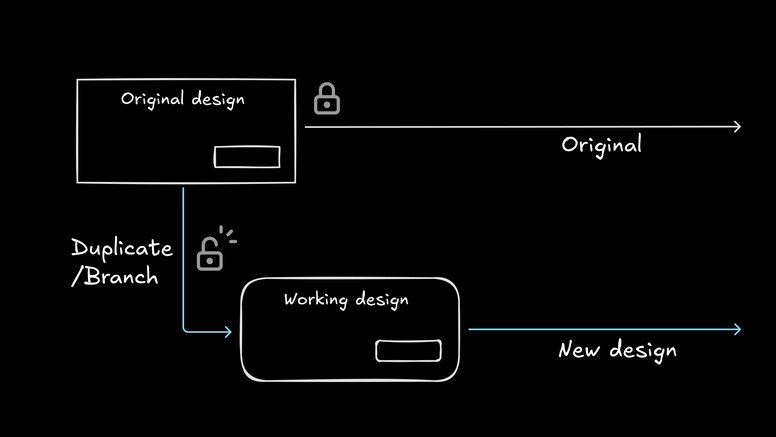
In Git, this is exactly what happens when you create a new branch. You carve off a fresh copy of the site or app, ready for wild ideas or responsible fixes, all safely insulated from whatever’s live. The original stays locked behind glass; your creative chaos stays in its own little paddock.
(In fact, Figma also offers a more robust branching feature for designing on large teams, and their documentation about it is a very designer-friendly way to understand the concept better.)
Imagine you have a new landing page. Your PM wants to A/B test designs, and you want to split the effort between two designers. Instead of crowding into the same Figma frames, you each branch off from the original, clearly labelling your own sandboxes.
This parallel play is more than just convenience. It’s operational safety. If your experiment works, great. If Maria’s is better, that’s great too. Worst case, you toss a few branches, and no one wakes up to broken layouts or missing nav bars.
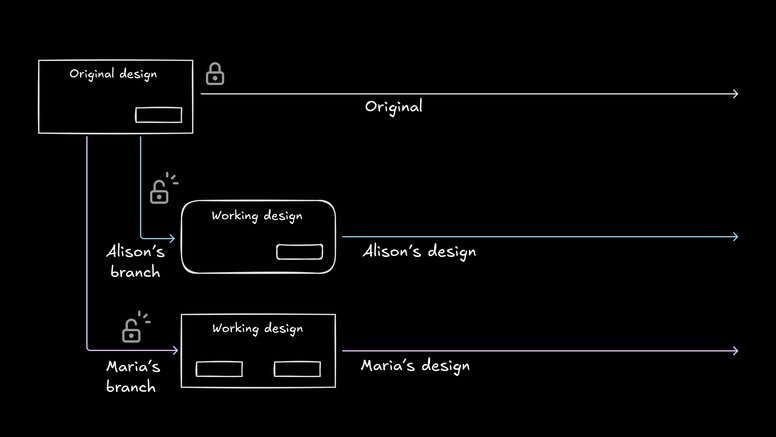
Things only get messy when you fail to label your work, or you try to work on the exact same frame duplicate as a coworker. If you both grab the same text box and try to move it, it’s funny the first few times, and then just chaotic and counter-productive.
This is the same as in code. Everyone gets their own siloed, custom-named branch, progress moves fast, and the stuff that actually ships only does so after everyone’s had their say. Collaboration, minus the headache and risk.
So your experiment didn’t crash and burn. Nice! But in the code world, those changes don’t teleport directly into the main branch. Instead, you submit a pull request (PR), a formal proposal saying, “Hey team, here’s what I changed. Ready for review?”
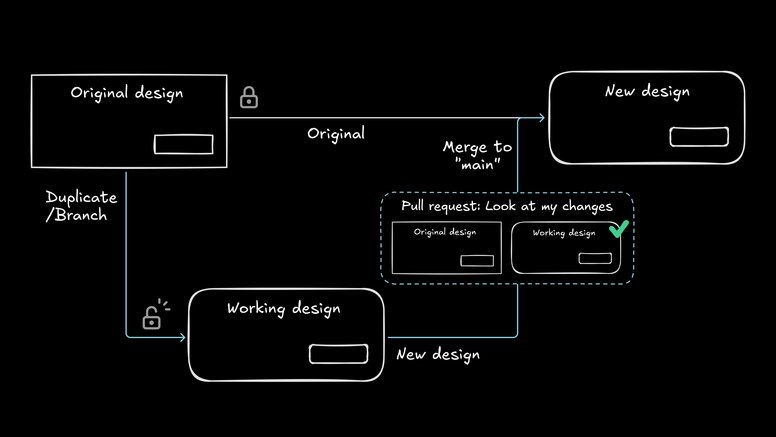
A PR automatically bundles up your branch’s changes, so teammates (usually developers, sometimes designers too) can review, comment, and ask questions before anything is merged to the main branch (production).
Only after everyone’s signed off do you hit “merge,” bringing those changes safely into production. Think of the PR as a checkpoint: nothing dangerous can sneak through without review, and you always have a chance to course-correct before it goes live.
Here’s where things get spicy. Imagine if two designers make two different changes. Well, both can be merged, and the result will be the sum of their changes.
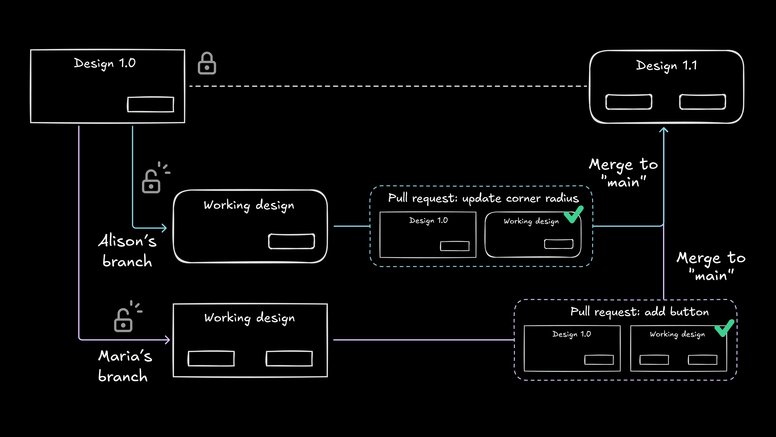
But if two designers tweak the exact same element in their own duplicated Figma frames, somebody eventually has to decide whose version wins. In Figma, you’ll eyeball it and copy-paste the preferred variant back to the main design, maybe doing some manual blend of the changes.
Code is less forgiving. If two branches change the same lines of a file, Git refuses to merge them blindly. This conflict blocks the entire pull request (even changes unrelated to the conflict) until someone reviews, discusses, and resolves the differences manually. Nothing ships until you and your team agree on which change gets to live in production.
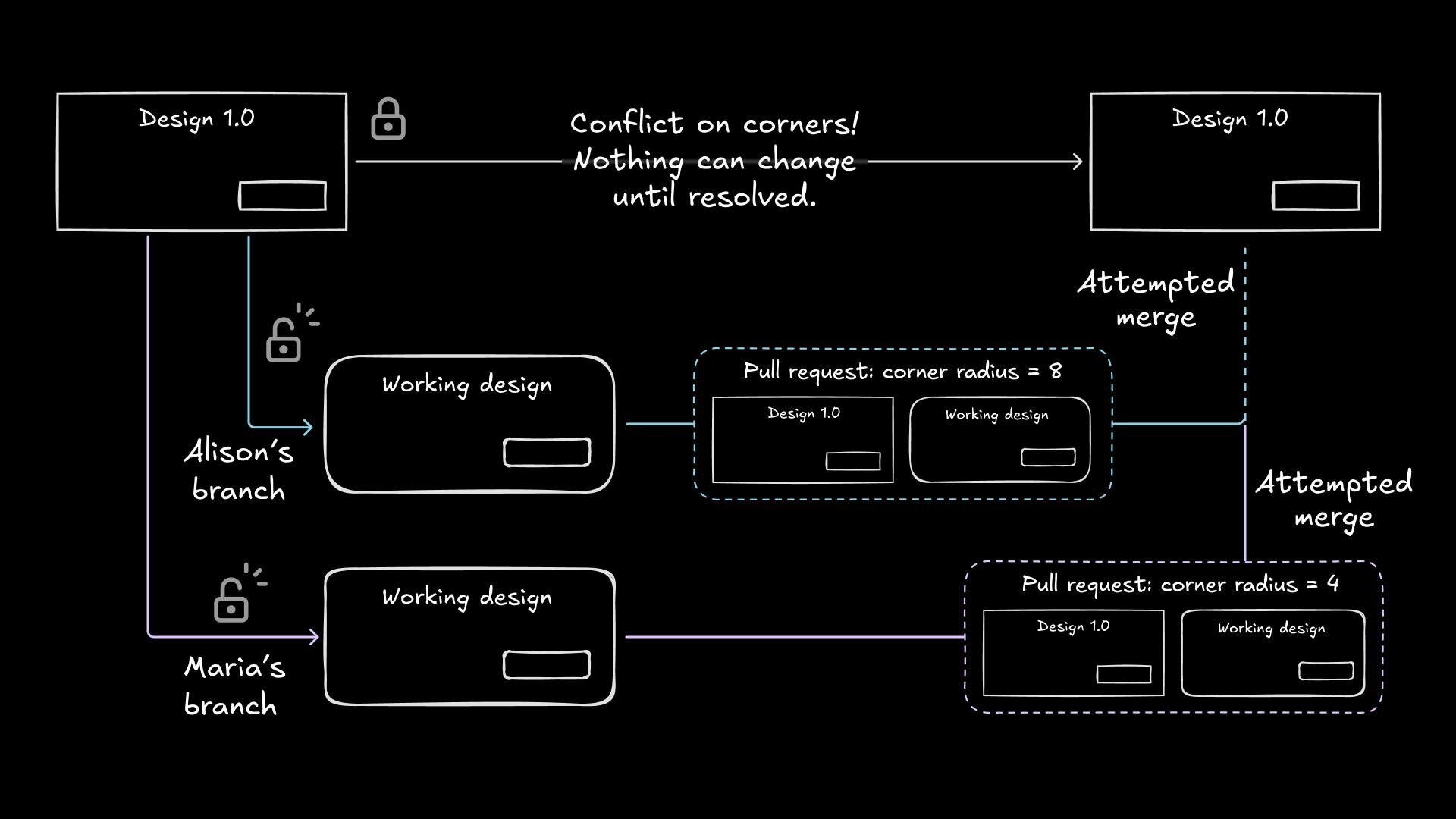
This is why it’s crucial to keep PRs small and focused. The smaller your change, the less chance it’ll collide with someone else’s work, and the less cryptic error messages if it does.
Merging in Figma is a trust exercise. You flip between frames, trying to catch every little difference, but if a 0.5px border-radius goes missing, odds are you’ll never spot it. It’s quick, but risky.
Code doesn’t work that way. Every change is tracked, from headline overhauls to micro-adjustments. All old versions hang around in case you need to hit rewind. And before anything merges, your team gets a “diff,” a side-by-side view that highlights every individual edit.
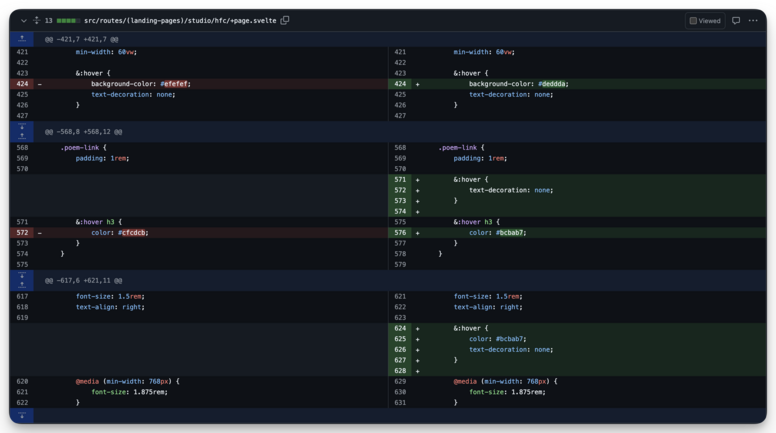
Developers can see exactly what changed before they give the green light, which is crucial because even a minor tweak can take down a site. If you hear talk of continuous integration (CI) pipelines, these are basically automated tests and other processes that run on every pull request to ensure code won’t nuke production.
Also, once the branch finally merges, the safety net doesn’t vanish. Git keeps track of all version history, ready in case you need to smash the undo button a few times.
All of this is why, with our AI visual canvas, Fusion, we don’t reinvent the wheel. Git is the gold standard, so we work with it rather than against it. With Fusion + Git, developers get the final say when it comes to code, and designers get the final say in UI design.
Fusion gives you a visual interface to branch your real site and design directly on it—all without ever having to touch actual code.
You can nudge pixels in our visual editor, prompt the AI for larger changes, or even upload Figma designs for modifications to existing components (or entirely new ones). All the while, Fusion shows you how your design will look for real users across screen sizes.
When you’re done making changes to a given section of the site, you can hit “Send PR.” Builder.io’s bot rolls up your visual edits into a plain-English summary on a pull request, so developers can see at a glance (and in their trusty line-by-line diff) exactly what you changed. All without you having to keep track manually.
If something’s fuzzy or feels like it could explode on release day, devs can ping you for details before anything hits production. Both your designs and the live site stay protected.
Your main job is just to ship your ideas. “Send PR” is there for you whenever you’re ready to propose changes to your team. Just remember, unless your team uses something like GitHub Code Owners, developers don’t always get a magic notification when a new PR lands, so you may need to tag them in the PR or Slack.
If you need to tweak your branch after opening the PR, that's okay, too. Just make changes on the same branch in Fusion, and then hit “Update PR.” The PR gets more commits (code changes), and your designs stay clearly documented for everyone reviewing.
Finally, when your developer merges and deletes your branch in GitHub (or GitLab or Bitbucket, or wherever your code lives), Fusion automatically clears out that branch too. Everything stays tidy, synced, and ready for your next big idea.
For best results in Fusion:
- Keep your changes small and focused. The smaller your updates, the easier they are to review, merge, and—if necessary—undo.
- Name your branches after the feature or component you’re working on. “fix-login-button” beats “alice-123-final-final-v2.”
- Be extra careful with shared components. Updating a single button might update it everywhere on the site. It’s like using Figma components: scope your changes, check a few key screens, and flag anything that might be a ripple effect.
- Don’t stress over documenting every detail. Fusion’s workflow (and bot) helps show developers what changed, both as a summary and as a diff.
- Ask for reviews—and add context as needed. If you change a shared or critical component, leave a comment in the PR so everyone’s on the same page. PR comments in GitHub are perfect for this.
A little communication and a bit of caution with shared components will save your team from surprise layouts and late-night bug hunts.
Branching isn’t some mystical dev-only magic. It’s as natural for designers as duplicating a Figma frame.
The safer your experiments, the bolder your best ideas. And with Fusion, you get the same clarity developers rely on: detailed history, code diffs, and a workflow that protects both your creativity and the live site.
Track your changes. Watch for those shared components. And when you’re ready, hit “New Branch” in Fusion and build something epic without ever having to touch code.
Builder.io visually edits code, uses your design system, and sends pull requests.
Builder.io visually edits code, uses your design system, and sends pull requests.




 Connect a Repo
Connect a Repo








